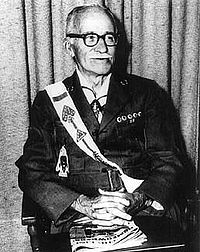E. Urner Goodman
| E. Urner Goodman | |
|---|---|

Dr. E. Urner Goodman
|
|
| Born | May 15, 1891 Philadelphia, Pennsylvania |
| Died | March 13, 1980 (aged 88) New York City |
| Resting place | Penney Farms, Florida |
| Occupation | Professional Scouter |
| Spouse(s) | Louise Wynkoop Waygood |
| Children | Theodore, George, Lydia Ann |
| Parent(s) | George and Ella Goodman |
Silver Buffalo Award
OA Distinguished Service Award
OA Vigil Honor
Honorary Doctorate in Humanics
Honorary Chief of the Blackfoot Indians
Honorary Alpha Phi Omega brother
Edward Urner Goodman (May 15, 1891 – March 13, 1980) was an influential leader in the Boy Scouts of America (BSA) movement for much of the twentieth century. Goodman was the national program director from 1931 until 1951, during the organization's formative years of significant growth when the Cub Scouting and Exploring programs were established. He developed the BSA's national training center in the early 1930s and was responsible for publication of the widely read Boy Scout Handbook and other Scouting books, writing the Leaders Handbook used by Scout leaders in the United States during the 1930s and 1940s. In the 1950s, Goodman was Executive Director of Men's Work for the National Council of Churches in New York City and active in church work.
Goodman is best remembered today for having created the Order of the Arrow (OA), a popular and highly successful program of the BSA that continues to honor Scouts for their cheerful service. Since its founding in 1915, the Order of the Arrow has grown to become a nationwide program having thousands of members, which recognizes those Scouts who best exemplify the virtues of cheerful service, camping, and leadership by membership in BSA's honor society. As of 2007, the Order of the Arrow has more than 183,000 members.
Goodman was born and raised in Philadelphia, Pennsylvania, where his father, George, was a printer and real estate agent. His mother, Ella, died of typhoid fever in early 1895 when Goodman was just three years old. He attended Central High School, graduating in 1909. He enjoyed writing and began keeping a detailed journal of daily activities during his senior year of high school, expressing his aspirations for the future along with occasional doubts. With several classmates, he began a literary club and published a newsletter, The Inkstand. He also showed interest in music, playing the piano and violin, and composed a song for his high school senior class. When it was not selected by the class officers, he wrote in his journal of his disappointment.
...
Wikipedia
